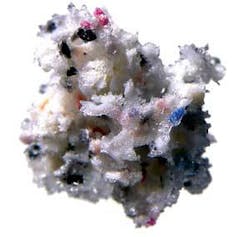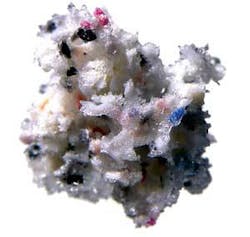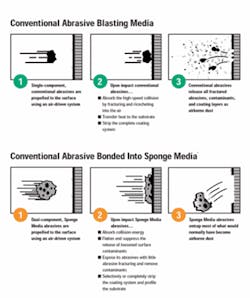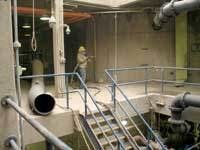Sponge Media Aids in Safe Removal of Lead-Based Coatings
Contractors used a sponge media abrasive blasting system to remove lead-based paint from concrete structures at a New York City wastewater treatment plant. The project involved removal of the paint while the facility remained fully operational.
The wastewater treatment plant (WWTP) serves Queens Borough, with a population of 2,237,216 (2004 U.S. Census Bureau estimate) within its 109-square-mile border.
This 1930s-era WWTP is operated by the New York Department of Environmental Protection (DEP), which owns and operates 14 wastewater treatment plants in New York City. Five of the plants, including this one, are being upgraded to step-feed biological nutrient removal (BNR) to achieve compliance with a Nitrogen Administrative Consent Order relative to nutrient removals pursuant to Long Island Sound Study goals.
Although this WWTP comprises several antiquated structures, the facility has earned numerous performance, safety, and maintenance honors over the years including the National Association of Clean Water Agency’s (NACWA) Gold Award for 100 percent compliance with their National Pollutant Discharge Elimination System (NPDES) permits for an entire calendar year.
In addition to new construction, a large building at the WWTP site was slated for major remodel and renovation. When the building’s interior was tested, lead-based paint was found on concrete structures such as underground tunnels and walls. Since the facility was slated for major remodel rather than minor repaint, 200,000 square feet of lead-based coating had to be removed prior to any major work on the structure.
The project was made challenging by the imperative that the facility stay operational during the process. Specialists initially specified that the lead paint be removed with chemical strippers. Subcontractor to the overall project, Four Silver Star Painting of Roslyn Harbor, NY, was selected to perform the work. Four Silver Star is registered as a Disadvantage Business Enterprise (DBE) and Woman Business Enterprise (WBE).
Before the work was slated to commence, Four Silver Star President Bobbi Jo Tavenner visited the site and voiced concerns with using chemical strippers to remove the paint.
The building to be remodeled was comprised of numerous odd-shaped spaces. Lead-based paint was peeling and cracking on walls, tunnels and ceilings. Since an important part of the chemical stripping process is to remove the chemical and stripped paint with the use of power washers, the issue became how to deal with collection of tainted fluids.
In applications where fluid containment is more effective, such as tank interiors, it is not normally a difficult task. In such instances, chemical strippers may indeed be the most effective route: The stripper is applied and the wash-down water contained, vacuumed up, and sent to a certified hazardous waste collection facility for disposal.
But this facility was divided into many odd-shaped areas. The facility could not be closed during the paint removal process, so the project would have to be attacked in a piecemeal fashion. In addition, the project was to be accomplished weekdays, during normal working hours. There would be scant time for strippers to chemically react with the coating. Finally, Four Silver Star workers were instructed to completely clean up after each shift, rather than leave material and equipment in the building.
Storage of hazardous wastewater that would be associated with chemical stripping was also a concern.
Since the facility was to remain operational, regular sandblasting was not a viable alternative. Conventional blast media used in building interiors typically throws off too much airborne dust to allow anyone but contractors to remain on site. Especially with blast residue containing lead dust, it becomes an engineering control issue to maintain integrity.
Four Silver Star proposed a technology that would allow the WWTP goals to be met - a sponge-based media blasting system offered by Sponge-Jet Inc.
Alternative Selected
In conventional media blasting, single-component particles are propelled by air to great speeds. When the particles collide with the painted surface, the particles strip the coatings and ricochet into the air. There they release all fractured abrasives, contaminants, and coating layers as airborne dust. However, when conventional abrasives are bonded into a sponge media, the collision suppresses the release of loosened material and the sponge media entraps what normally would become airborne dust.
Sponge-Jet Sponge media suppresses dust by relying on several unique characteristics, which together are referred to as sponge media’s MicrocontainmentTM feature. The pliant nature of the sponge media - a water-based, open-celled polyurethane impregnated with abrasives - allows it to flatten on impact. As the sponge flattens, it exposes its bonded abrasives, which dislodge the coating or contaminant from the substrate. After leaving the surface, the sponge media resumes its original shape, capturing up to 99% of what might have become airborne dust.
Because of the lower dust level, operator vision is enhanced. Users have also found the combination of lower clean-up and containment costs, lower overall media usage rates (due to Sponge media’s reusability), lower inbound and outbound freight costs, and lower disposal costs (when compared to traditional abrasive blasting processes) often lead to lower total job costs.
The WWTP’s engineers were open to Sponge-Jet technology, but were naturally cautious. After accepting reams of documentation from Four Silver Star and Sponge-Jet, the decision was made to proceed using sponge-encapsulated blast media technology. However, the WWTP retained the right to insist that Four Silver Star revert to chemical strippers at any time and for any reason.
Four Silver Star’s crew erected temporary tent-like dust control structures around scaffolding and attacked the 200,000 square foot project in small portions. A 40,000 cfm dust collector was connected to the containment structures to keep even miniscule amounts of airborne dust from leaving the containment. A coatings-removal team vacuumed up spent abrasive material while others blasted.
The first day on the job, the WWTP and DEP resident engineers, plant supervisors, and consulting engineers witnessed how well the sponges cut and how well the dust was maintained. Using Sponge-Jet’s encapsulated abrasives to move the project along at a rapid pace while allowing the plant to remain fully operational, the WWTP was able to have the facility completely stripped of all toxic lead-based paint and ready for other phases of the renovation on time.
About the Author:
Jack Innis is a National Association of Corrosion Engineers (NACE) level-one certified coating inspector. His work appears regularly in high-performance coating trade journals.



